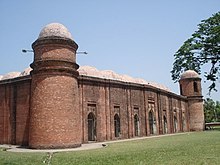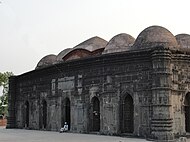Islam made its first appearance in the Bengal region during the 7th century AD by Arab Muslim traders and Sufi missionaries, and the subsequent Muslim conquest of Bengal in the 12th century led to the rooting of Islam across the region. Beginning in 1202, a military commander from the Delhi Sultanate, Bakhtiar Khilji, overran Bihar and Bengal. He conquered Nabadwip from the old emperor Lakshman Sen in 1203. and intruded into much of Bengal as far east as Rangpur andBogra ushering Muslim rule in this part of the world. Under the Muslim rulers, Bengal entered a new era as cities were developed; palaces, forts, mosques, mausoleums and gardens sprang up; roads and bridges were constructed; and new trade routes brought prosperity and a new cultural life.
However, smaller Hindu states continued to exist in the Southern and the Eastern parts of Bengal till the 1450s such as the Deva dynasty. Some independent small Hindu states were also established in Bengal during the Mughal period like those of Maharaja Pratapaditya of Jessore and Raja Sitaram Ray of Burdwan. These kingdoms contributed a lot to the economic and cultural landscape of Bengal. Militarily, these served as bulwarks against Portuguese and Burmese attacks. Many of these kingdoms are recorded to have fallen during the late 1700s. While Koch Bihar Kingdom in the North, flourished during the period of 16th and the 17th centuries as well till the advent of the British.
Turkic rule[edit]
In 1203 AD, the first Muslim ruler, Muhammad Bakhtiyar Khalji, a Turk, captured Nadia and established Muslim rule. The political influence of Islam began to spread in Bengal with the conquest of Nadia, the capital city of the Sen ruler Lakshmana, by him. Bakhtiyar captured Nadia in a unique way. Sensing the presence of a strong army of Lakshmana Sen on the main route to Nadia, Bakhtyar proceeded instead through the jungle of Jharkhand. He divided his army into several groups, and he himself led a group of 17 horsemen and advanced towards Nadia in the guise of horse-traders. In this manner, Bakhtiyar had no problem in entering through the gates of the royal palace. Shortly afterwards, Bakhityar's main army also joined him and within a short while Nadia was captured. After capturing Nadia, Bakhtiyar advanced towards Gauda (Lakhnuti), another capital of the Sena kingdom, conquered it and made it his capital in 1205. Next year, Bakhtiyar set out for an expedition to capture Tibet, but this attempt failed and he had to return to Bengal with poor health and a reduced army. Shortly afterwards, he was killed by one of his commanders, Ali Mardan Khalji. Defeated Lakshman Sen and his two sons moved to a place then called Vikramapur (present-day Munshiganj District in Bangladesh), where their diminished dominion lasted until the late 13th century.
Khiljis[edit]
The period after Bakhtiar Khilji's death in 1207 devolved into infighting among the Khiljis - representative of a pattern of succession struggles and intra-empire intrigues during later Turkic regimes. Ghiyasuddin Iwaz Khalji prevailed and extended the Sultan's domain south to Jessore and made the eastern Bang province a tributary. The capital was made at Lakhnauti on the Ganges near the older Bengal capital of Gaur. He managed to make Kamarupa and Trihut pay tribute to him. But he was later defeated by Shams-ud-Din Iltutmish.
Mamluk rule[edit]
The weak successors of Iltutmish encouraged the local governors to declare independence. Bengal was sufficiently remote from Delhi that its governors would declare independence on occasion, styling themselves as Sultans of Bengal. It was during this time that Bengal earned the name "Bulgakpur" (land of the rebels). Tughral Togun Khan added Oudh and Bihar to Bengal. Mughisuddin Yuzbak also conquered Bihar and Oudh from Delhi but was killed during an unsuccessful expedition in Assam. Two Turkic attempts to push east of the broad Jamuna and Brahmaputra rivers were repulsed, but a third led by Mughisuddin Tughralconquered the Sonargaon area south of Dhaka to Faridpur, bringing the Sen Kingdom officially to an end by 1277. Mughisuddin Tughral repulsed two massive attacks of the sultanate of Delhi before finally being defeated and killed by Ghiyas ud din Balban.
Mahmud Shahi dynasty[edit]
Mahmud Shahi dynasty started when Nasiruddin Bughra Khan declared independence in Bengal. Thus, Bengal regained her independence back. Nasiruddin Bughra Khan and his successors ruled Bengal for 23 years finally being incorporated into Delhi Sultanate by Ghyiasuddin Tughlaq.
Ilyas Shahi dynasty[edit]
Shamsuddin Iliyas Shah founded an independent dynasty that lasted from 1342 to 1487. The dynasty successfully repulsed attempts by Delhi to conquer them. They continued to reel in the territory of modern-day Bengal, reaching to Khulna in the south and Sylhet in the east. The sultans advanced civic institutions and became more responsive and "native" in their outlook and cut loose from Delhi. Considerable architectural projects were completed including the massive Adina Mosqueand the Darasbari Mosque which still stands in Bangladesh near the border. The Sultans of Bengal were patrons of Bengali literature and began a process in which Bengali culture and identity would flourish. During the rule of this dynasty, Bengal, for the first time, achieved its identity. Indeed, Ilyas Shah named this province as 'Bangalah' and united different parts into a single, unified territory. The Ilyas Shahi Dynasty was interrupted by an uprising by the Hindus under Raja Ganesha. However, the Ilyas Shahi dynasty was restored by Nasiruddin Mahmud Shah. Famous globe-trotter, Ibn Battuta arrived Bengal this reign.[26] In his account of Bengal in his Rihla, he depicts a land full of abundance. Bengal was a progressive state with commercial links to China, Java, Ceylon. Merchant ships were available from various destinations.
Ganesha dynasty[edit]
The Ganesha dynasty began with Raja Ganesha in 1414. After Raja Ganesha seized control over Bengal, he faced an imminent threat of invasion. Ganesha appealed to a powerful Muslim holy man named Qutb al Alam, to stop the threat. The saint agreed on the condition that Raja Ganesha's son Jadu would convert to Islam and rule in his place. Raja Ganesha agreed and Jadu started ruling Bengal as Jalaluddin Muhammad Shah in 1415 AD. Qutb al Alam died in 1416 AD and Raja Ganesha was emboldened to depose his son and accede to the throne himself as Danujamarddana Deva. Jalaluddin was reconverted to Hinduism by the Golden Cow ritual. After the death of his father he once again converted to Islam and started ruling his second phase. Jalaluddin's son, Shamsuddin Ahmad Shah ruled for only 3 years due to chaos and anarchy. The dynasty is known for their liberal policy as well as justice and charity.
Hussain Shahi dynasty[edit]
The Habshi rule gave way to the Hussain Shahi dynasty that ruled from 1494 to 1538. Alauddin Hussain Shah, considered as the greatest of all the sultans of Bengal for bringing cultural renaissance during his reign. He extended the sultanate all the way to the port of Chittagong, which witnessed the arrival of the first Portuguese merchants. Nasiruddin Nasrat Shah gave refuge to the Afghan lords during the invasion of Babur though he remained neutral. However, Nusrat Shah made a treaty with Babur and saved Bengal from a Mughal invasion. The last Sultan of the dynasty, who continued to rule from Gaur, had to contend with rising Afghan activity on his northwestern border. Eventually, the Afghans broke through and sacked the capital in 1538 where they remained for several decades until the arrival of the Mughals.




No comments:
Post a Comment